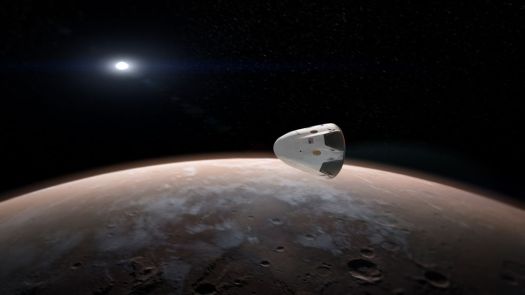
I’d like to think someone at SpaceX or NASA is reading my blog and took the last post to heart, though I could with equal validity claim to be a fire engine or the Easter Bunny.
SpaceX’s big announcement yesterday that they will be sending a Dragon capsule to Mars in (hopefully) two years clearly has been in the works for some time. They didn’t just cook that idea up last weekend over some takeout pizza and a twelve-pack of Red Bull (though from what they say about the work environment at Hawthorne, who knows?). From Aviation Week:
SpaceX and NASA wrapped up 16 months of behind-the-scenes negotiations Tuesday with an unfunded Space Act agreement to cooperate on sending an unmanned Dragon crew capsule to the surface of Mars as early as 2018.
Smart. 2018 is the next window of opportunity for a Hohmann transfer to Mars, and ought to be enough time to pull this off given SpaceX’s current state of development. They’re getting the propulsive-landing thing down pretty well and Mars access has been an intended use of Dragon 2 all along. If this works, the repercussions will be tremendous.

Falcon Heavy is probably the long pole in the tent because Red Dragon isn’t going very far if they can’t put enough weight up there to get the job done (that is, a kick stage to put Dragon on a transfer orbit). If this year’s test is successful, there are a couple more Heavy launches on next year’s manifest that would go a long way towards building confidence in their capability.
Note that NASA isn’t throwing money at them (directly at least) so this is all on Elon’s dime. But the “in kind” support they’re providing is significant, as Aviation Week reports:
…“deep space communications and telemetry; deep space navigation and trajectory design; entry, descent and landing system analysis and engineering support; Mars entry aerodynamic/aerothermal database development; general interplanetary mission and hardware consultation and advice, and planetary protection consultation and advice.”
These are subjects in which NASA has lots of expertise that SpaceX likely doesn’t have (yet). Their focus has been on the foundational work: vehicle development and operating experience, whereas this is precisely what a government space organization should be doing: figuring out the really hard, expensive stuff in an R&D role and then letting private industry run with it. It’s worth remembering that most of the airfoil designs still in use today by Boeing and others were developed by NASA’s precursor (NACA) in the 40’s and 50’s.
And if this works, there’s still time to build a hab module for that 2021 window…
